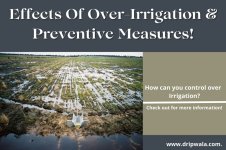dripwala
Farm Hand
- Messages
- 25

Introduction Of Over Irrigation:
Over irrigation means the artificial application of excessive water to land to assist in the production of crops. It is mainly done where there are drylands. It leads to dampness and sanity of soil.For most crops, growers want to avoid drought stress throughout the growing season because it can quickly reduce yield and lead to a misshapen, undersized, and prematurely ripened crop. Applying “a little extra” is seen as easy insurance against these problems and makes good sense, since it may also provide a time buffer if the next irrigation must be delayed because of a breakdown or a suddenly required chemical application.
“A little extra” turns into “too much” when the irrigation increases soil moisture in the active root zone above field capacity. Soil can store water for crop use, and field capacity is the upper limit of this storage. Any additional water applied beyond this limit begins to immediately drain by gravity out of the root zone, lost for crop use, and leaching valuable nitrogen.
Soil Type Plays A Role
If the soil is well-drained, this will happen rapidly, and the main losses are water and nutrients. In slowly draining soils, the excess moisture can cause low-oxygen or even saturated conditions. Depending on how severe the waterlogging becomes and how long it persists, the uptake of water and nutrients by the roots is slowed down and the productivity of the canopy is reduced. Waterlogging for more than two days during the growing season will outright kill at least some of the roots.What Are Some Other Consequences Of Over-Irrigation?
Apart from increased salinity and crossing the field capacity threshold, here are additional adverse effects of over-irrigation:- Rising weed pressure
- Lowered yield
- Higher pumping costs
- Water loss
- Nitrogen loss due to denitrification and leaching
- Many diseases (e.g., phytophthora crown and root rot and armillaria root rot) can shorten plant lifespans and reduce tree vigor.
5 Tips For Water Saving Irrigation
1. Mulch Trees and Garden BedsIn addition to beautifying the land, mulch provides numerous services, from managing weeds to controlling soil erosion. When it comes to water, mulch reduces evaporation and works to retain soil moisture. Wood, pine straw, and other plant-based mulches also add organic material to the garden over time, which help improve the water-holding capacity of soils.
2. Water Deeply, Not Frequently
Think slow and deep when irrigating lands. When water is applied too quickly, much is lost to runoff. Irrigating slowly allows water to soak into the ground. Drip irrigation is excellent for this purpose, but lowering the water flow to sprinklers also works. Allow irrigation to run long enough to wet soils to a depth of six inches. Deep irrigation encourages healthier root systems. Watering too frequently and too shallow encourages shallow root systems that are more susceptible to drought. Reduce the frequency of watering, allowing soils to dry between watering. Finally, adjust irrigation according to plant age. Older plants have deeper, more extensive root systems and often require less frequent irrigation.
3. Use Pressure Regulation
Pressure regulation helps ensure that sprinklers are operating at the optimal level. When pressure is too high, water droplets atomize, which results in significant amounts of water being carried off-site by wind drift. By reducing the operating pressure, the water drops are larger and heavier and are more likely to land where intended.
4. Maintain Sprinklers and Irrigation Systems
We all know how much water a leaking toilet can waste. In the landscape, leaky faucets and broken sprinkler heads can also waste huge amounts of water. Taking time to periodically check irrigation equipment and connections can save a lot of money on your water bill. Look for leaks and broken, buried, or jammed sprinkler heads. Traditional hose connections at the faucet and sprinkler can also leak and are easily repaired.
5. Get Smart Technology
If you are using an irrigation system, consider upgrading to a “smart” controller or installing a rain sensor. Smart water controllers measure weather and soil moisture conditions to automatically adjust watering schedules according to landscape conditions. Rain sensors are inexpensive and can be retrofitted to most irrigations systems. Adjust irrigation systems for current conditions. Try to avoid the habit of “set it and forget it,” as the plant needs to change throughout the year.
Whether you are tech-savvy or traditional, these simple management practices will save you money in maintenance, while conserving and protecting this finite resource.
- Water Flow Meters: Water flow meters can accurately measure how much water is being used to irrigate so that water use can be precisely managed and unnecessary watering can be avoided.
- Soil sensors: Soil sensors can help farmers understand the condition of roots to suggest when it is time to irrigate or when the plant’s thirst is quenched to prevent wasting water
- Irrigation Management Mobile Apps: Mobile apps that can assist farmers with irrigation management are continuously improving. enabling farmers to quickly adjust their irrigation based on changing conditions.

